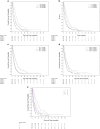Plasma inflammatory cytokines and survival of pancreatic cancer patients
- PMID: 29691365
- PMCID: PMC5915593
- DOI: 10.1038/s41424-018-0008-5
Plasma inflammatory cytokines and survival of pancreatic cancer patients
Abstract
Objectives: Inflammation and inflammatory conditions have been associated with pancreatic cancer risk and progression in a number of clinical, epidemiological, and animal model studies. The goal of the present study is to identify plasma markers of inflammation associated with survival of pancreatic cancer patients, and assess their joint contribution to patient outcome.
Methods: We measured circulating levels of four established markers of inflammation (C-reactive protein (CRP), interleukin-6 (IL-6), soluble tumor necrosis factor receptor type II (sTNF-RII), and macrophage inhibitory cytokine-1 (MIC-1)) in 446 patients enrolled in an ongoing prospective clinic-based study. Hazard ratios (HRs) and 95% confidence intervals (CI) for death were estimated using multivariate Cox proportional hazards models.
Results: Overall mortality was significantly increased in patients in the top quartile of CRP (HR = 2.52, 95% CI: 1.82-3.49), IL-6 (HR = 2.78, 95% CI: 2.03-3.81), sTNF-RII (HR = 2.00, 95% CI: 1.46-2.72), and MIC-1 (HR = 2.53, 95% CI: 1.83-3.50), compared to those in the bottom quartile (P-trend <0.0001 for all four comparisons). Furthermore, patients with higher circulating concentrations of all four cytokines had a median survival of 3.7 months; whereas, those with lower levels had a median survival of 19.2 months (HR = 4.55, 95% CI: 2.87-7.20, P-trend <0.0001).
Conclusion: Individual elevated plasma inflammatory cytokines are associated with significant and dramatic reductions in pancreatic cancer patient survival. Furthermore, we observed an independent combined effect of those cytokines on patient survival, suggesting that multiple inflammatory pathways are likely involved in PDAC progression. Future research efforts to target the inflammatory state using combination strategies in pancreatic cancer patients are warranted.
Conflict of interest statement
Figures
References
Publication types
MeSH terms
Substances
Grants and funding
LinkOut - more resources
Full Text Sources
Other Literature Sources
Medical
Research Materials
Miscellaneous


